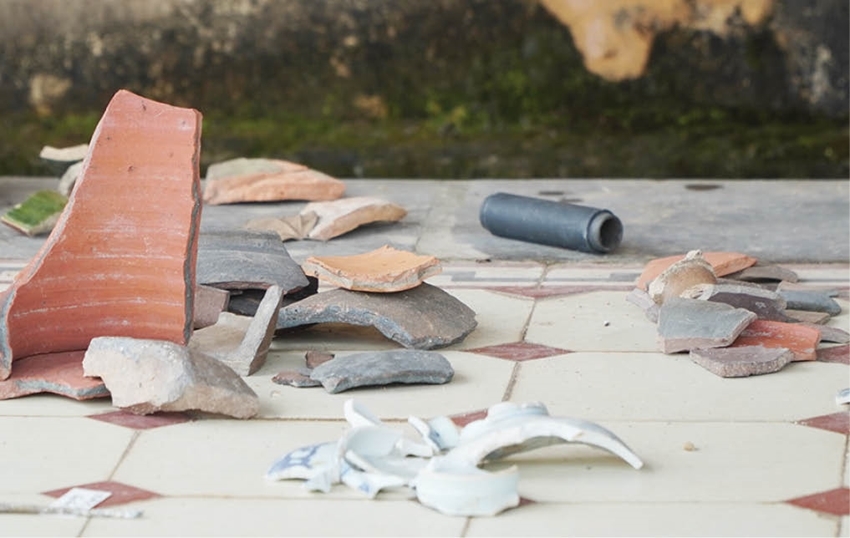“Decoding” the structure foundation
Built in 1833 during the reign of Minh Mang, Dai Cung Mon was a special architectural structure located between Thai Hoa Palace and Can Chanh Palace. With five compartments and three doors (the middle door reserved exclusively for the emperor), the front was painted with vermilion lacquer and gilded magnificently, decorated with the eight treasures, four sacred animals, poetry, and literature. The back had two corridors connecting to Ta Vu and Huu Vu houses. These two corridors were 9 compartments long, facing north, covered with blue glazed tiles. Dai Cung Mon was once a symbol of majesty in the overall architecture of Hue Imperial City. The structure was completely destroyed in 1947 during the war, leaving only the foundation.
From March to April 2025, the National Museum of History collaborated with Hue Monuments Conservation Center (HMCC) to conduct archaeological excavation over an area of more than 60m², aimed at determining the scale, structure and foundation construction of Dai Cung Mon - a prerequisite for being able to reconstruct the structure.

The archaeological team collected 402 artifact fragments during the excavation process
Archaeological results show that the structure has a rectangular ground plan (23.72m long, 12.48m wide), exactly matching the description in historical records. The remaining traces, such as the foundation binding system on four sides, traces of front and rear step foundations, five original brick pillar foundations, and many other reinforcing pillar foundations, have contributed to recreating this special architectural space.
As for Mr. Nguyen Ngoc Chat, Deputy Head of Research and Collection Department, National Museum of History, through the stratigraphic survey, two architectural layers were identified: the old foundation layer from the Gia Long period, including traces of two gates of Ta Tuc and Huu Tuc; and the foundation of Dai Cung Mon built during Minh Mang period. Despite many renovation phases, the scale and ground plan structure remained unchanged. “From research, observation, comparison, and analysis based on stratigraphic structure, we can confirm the entire structure and scale of the architectural foundation of Dai Cung Mon from construction until destruction, despite many renovations, remained completely unchanged,” said Mr. Chat.
The excavation team also collected over 400 artifact fragments, including bricks, stones, glazed ceramics, metals and so on, dating from the 16th to 20th centuries. These are valuable materials for reconstructing the structure and historical-architectural research.
“The research results and stratigraphic developments, the traces of architectural foundations exposed in this archaeological excavation show that Dai Cung Mon is the most severely destroyed architectural work compared to others in Hue Imperial Citadel that we have had the opportunity to research and excavate,” continued Mr. Nguyen Ngoc Chat.
Reconstruction is feasible
Based on archaeological traces and historical documents, experts assess that the restoration of Dai Cung Mon is completely feasible. HMCC’s Director Hoang Viet Trung commented: “The excavation results have provided many new insights, and, database is sufficient to determine the original scale and structure of the Dai Cung Mon architectural foundation. The reconstruction will ensure continuity from archaeology and historical elements.”
According to Resolution No. 91 of the People’s Council of Thua Thien Hue Province (now Hue City), the “Dai Cung Mon Reconstruction Project” will be implemented in 4 years from 2025, with a local budget contribution of nearly 65 billion dongs. The project will repair and restore the foundation part of the structure with bricks, pedestals paved with Thanh stone, steps paved with blue stone, and walls built with bricks and plastered with traditional colored plaster. The main frame will be made of group II wood, yellow-glazed tile roof, finely carved components, lacquered and gilded according to traditional techniques and arts. The corridors on both sides, handrail systems, guarding screens, stone-paved courtyards, lighting... will also be synchronously reconstructed.
HMCC’s Deputy Director Phan Van Tuan said: “Dai Cung Mon currently has almost no remaining traces. However, the archaeological results have helped us confirm the position of the center and axes system, and the materials used for reconstruction.”
The HMCC is completing procedures to launch the project in 2025. The implementation of restoration and reconstruction of the structure plays an important role and great significance in the process of fully restoring the architectural appearance of the Hue Imperial City monument complex.
With detailed archaeological results and systematic reconstruction orientation, Dai Cung Mon will no longer be a trace of the past but will soon be returned to the majestic appearance of the heritage left by our ancestors.